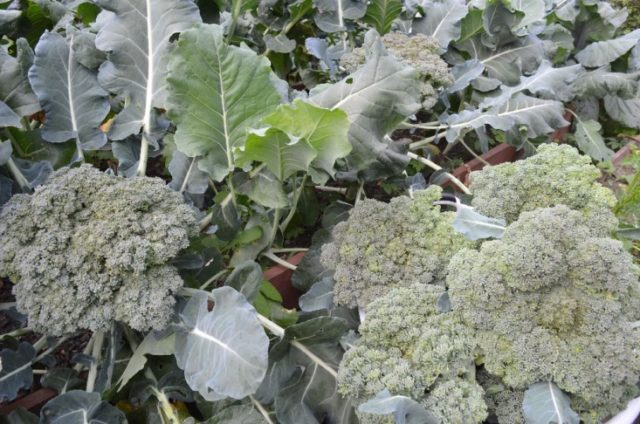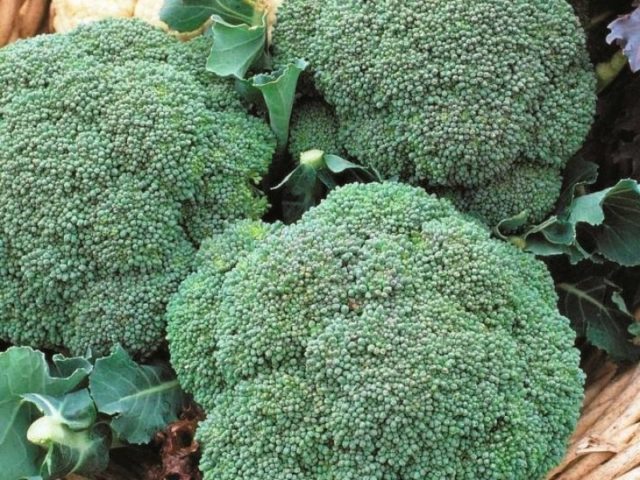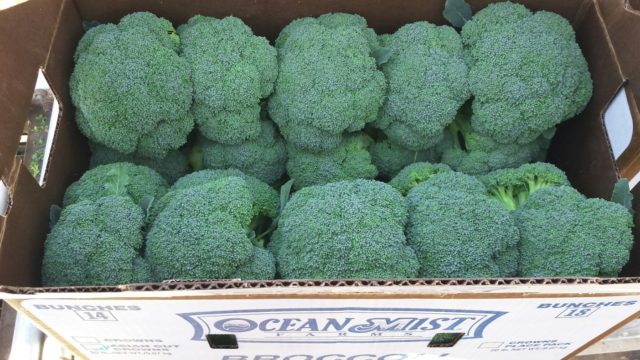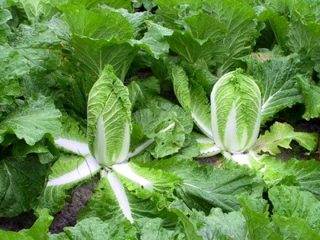Content
Fiesta broccoli cabbage is liked by gardeners for its undemanding growing conditions and frost resistance. The mid-early variety from the collection of the Dutch company Bejo Zaden is propagated by seedlings or direct sowing of seeds into the soil.

Fiesta broccoli hybrid is very similar to cauliflower, slightly different in shape, size and color of the head
Description of broccoli cabbage Fiesta F1
The plant creates a rosette of leaves tending upward. Blue-green leaf blades are long, 25-35 cm, wavy, weakly dissected, with bizarrely curving edges, a corrugated, as if blistery surface. A wax gray bloom is visible on top of the leaf blades. In height, the Fiesta hybrid reaches 90 cm along the length of the leaves. A medium-sized stump, typical for other representatives of different varieties of cabbage. The root system consists of a powerful central rod and numerous small shoots that supply the plant with food and are located close to the surface.
The head of Fiesta cabbage begins to form after 16-20 leaves have grown. Slightly flattened rounded top is formed from collected in bunches of dense, juicy stem shoots, very small, growing from a stump, numbering from 500 to 2000 thousand. The head of broccoli Fiesta F1 is up to 12-15 cm in diameter, strong, like a cauliflower. A bumpy surface of a rich green color with a slightly bluish-turquoise tint. Head weight up to 0.4-0.8kg. With all the rules of agricultural technology on fertile soil, the weight of the head of Fiesta F1 cabbage reaches 1.5 kg.
Lateral leaves partially cover the head. This factor slightly increases the resistance of the hybrid to drought, since the strong heat of broccoli does not tolerate well, becoming lethargic and quickly forming flower stalks without sufficient watering and shading. The Fiesta hybrid differs from other varieties in that it does not form side shoots. Sometimes they show up with sufficient watering and good care after the head is cut. The optimum temperature for growing broccoli is 18-24 ° C. Prolonged rainfall, typical for some regions of the middle zone of the country, contribute to the cultivation of this variety. Even young broccoli seedlings can withstand temperatures below 10 ° C.
Advantages and disadvantages
Broccoli Fiesta is considered a valuable variety of cabbage for its characteristics:
- high taste and dietary properties;
- good commercial performance;
- versatility;
- yield, keeping quality and transportability;
- unpretentiousness;
- frost resistance;
- resistance to fusarium.
Gardeners also name the disadvantages:
- lateral shoots do not grow;
- short time to collect heads.
Fiesta cabbage yield
Fiesta broccoli hybrid medium-yielding - from 1 sq. m collect from 2.5 to 3.5 kg. With good care, timely watering and feeding, the yield rises to 4.4 kg. Cabbage is grown on personal subsidiary plots and farms.

On fertile soils, during the formation of large heads, the stumps are spud up for stability
Planting and caring for broccoli cabbage fiesta
Broccoli is grown through seedlings or direct sowing to a permanent location. Before planting seeds in separate pots:
- disinfect;
- processed in a growth stimulator according to the instructions for the drug;
- germinate on wet wipes for 2-3 days;
- then they are carefully laid out with tweezers in the substrate in separate containers or in peat tablets.
For the substrate, mix garden soil, compost or humus, sand, a little wood ash, as a universal fertilizer for cabbage. Loose light soil will allow water to pass to the pallet, which is especially important when growing cabbage seedlings, which are often prone to black leg disease due to waterlogging of the soil.
Fiesta broccoli cabbage seeds are planted in containers or in a permanent place from the beginning of April in different regions. After 26-30 days, seedlings with a height of 15-23 cm with 5-8 leaves are transferred to the site, usually at the end of April or in May, until June. If sown in open ground in early spring, the seedlings are covered due to the activity of the cabbage flea.
Cabbage is grown in a spacious sunny area with slightly dense soil. Suitable soils are slightly acidic, neutral or alkaline:
- sandy loam;
- loam;
- clayey;
- chernozems.
The holes are broken at a distance of 50 cm. For sowing directly into the ground, 3-4 grains are used in one hole to a depth of 1-1.5 cm. Then the weak shoots are removed or planted. Add 2 tablespoons of wood ash and a handful of humus to the hole. The stem is deepened only up to the first leaves.
For a continuous crop conveyor, broccoli is sown every 10 days. When sown in late May or June, cabbage seedlings remain intact by the cruciferous flea, which emerges in early spring. Broccoli can bear fruit until the first frost in late September or October, just in time for this period.
Broccoli Fiesta F1 is responsive to abundant watering and feeding. A moisture-loving culture requires a constantly moist soil. Cabbage is watered 2-3 times a week depending on the frequency of precipitation, although the hybrid grows in short-term drought conditions and tolerates extreme heat. Sprinkling is carried out in the evening. To retain moisture in the soil, the broccoli area is mulched, at the same time blocking the growth of weeds.
The most effective dressing for broccoli Fiesta during periods:
- 3 weeks after planting, using organic, green infusion;
- at the time of head formation, using 20 g of ammonium nitrate or 40 g of potassium nitrate per 10 liters of water, dry wood ash;
- during the filling of the head, 12-15 days before the beginning of fruiting, they are fed with a solution of 50 g of superphosphate in a bucket of water.
After feeding, the area is watered abundantly.

Broccoli is practically not grown in a greenhouse, because it bears fruit well in the open field.
Diseases and pests
Cabbage is affected by fungal diseases, except for fusarium, which prevent and treat:
- prevention, starting with seed treatment;
- the use of Fitosporin, Baktofit or fungicides.
At the seedling stage in the open field, insecticides are used against fleas. Broccoli is annoyed by the cabbage fly, leaf-eating caterpillars of various insects, against which only insecticides are effective. Frequent sprinkling is used for aphids.
Application
Broccoli is stored in refrigerators for 2 months, in a room for a week. The frozen product is also healthy. Fresh salads, soups, mashed potatoes, stews are prepared from vegetables rich in protein and vitamins, but with a low fiber content, they are simply fried in oil.
Conclusion
Fiesta broccoli cabbage is unassuming and adapts to different growing conditions - high humidity, cool weather or short-term drought. The heads are collected in a week, otherwise the density is lost, and the flower stalks begin to bloom, which impairs the taste.








